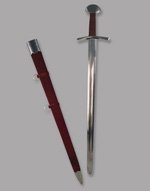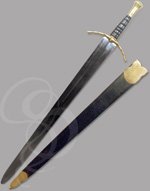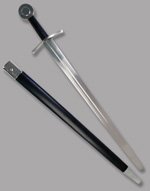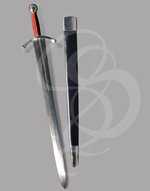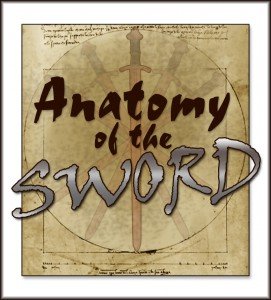
- What's a chappe?
- Where is the ricasso?
- What's the foible?
- What is the technical name for the channel that runs along the center of a blade?
- What's an ecusson?
If you don't know more than one of these (or if you said blood groove for the fourth question) then you are in the right place. The sad truth is, for many of us, our knowledge of the swords we love is reduced to the age-old adage, “stick them with the pointy end.” Fortunately for most of us, Strongblade is here to steer you onto the path of righteousness and swordsousness. In this new series of posts on the anatomy of swords, we will cover a number of different styles, with fancy 3D images and even fancier language. Stick with us, and you'll bring a napalm of knowledge to those online-forum flame-wars. You'll enthrall the wenches at the ren-faires with your clinical knowledge of killing tools. Yes, my friends, you will finally understand the Riddle of Steel. (And when you do, please explain it to me).
Without further Anneau, let us lunge right into our first specimen: The medieval arming sword.
The arming sword, sometimes called the knightly sword, is what everyone thinks of when they hear the word sword. Those of you reading this saying, "No, I thought of a katana", or "You're wrong, I was thinking of a scimitar", we'll watch a few episodes of Game of Thrones and then come back and tell me which type of sword comes to mind. By the way we will get to Katanas and Scimitars and other swords in time, but there is no better choice to begin this series than with the symbol of chivalry and honor, the knightly sword.
The arming sword is a fairly simple design. It owes its existence to even simpler weapons like the roman gladius and roman spatha (both of which were fantastic swords in their own right). Arming swords are meant to be fairly light and sharp on both edges. They are mostly used for slashing although they can be used by thrusting if you're feeling particularly stabby. These types of swords were classified by the all-time master of sword history, Ewart Oakeshott (God rest his soul).
Let's look closely at the parts of an arming sword:
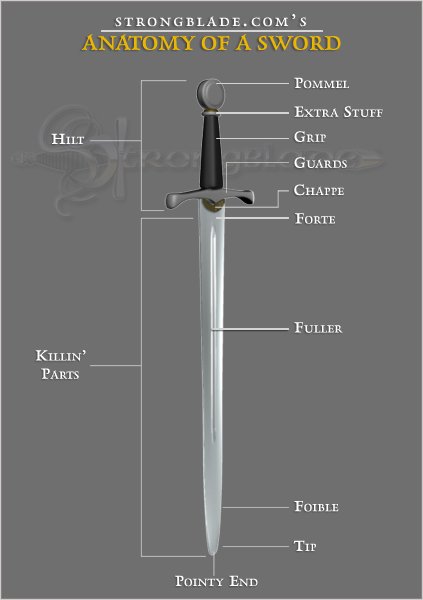
1. The Blade: Arming sword blades were typically around 30 inches in length, with a tapered point. Both edges were sharpened, and almost all had some sort of central ridge called a fuller (not a blood groove, folks). Most blades in the middle ages were made from carbon-steel, and tempered in a process of heating and quenching. Sometimes urine was involved. Seriously. All blades (except ones given to knights that no one liked) were made with a full tang.
2. The Fuller: Alhough the term "blood-groove" or "blood-gutter" is often used to describe this channel, those terms are misconceptions. There's no actual historical evidence to suggest that fullers allowed blood to drain from an opponent so that a vacuum would not trap the sword in said opponent's body. Fullers, rather, had a dual purpose (I think duel purpose would be acceptable here, too). These carved channels created a sort of "spine" to the blade, giving additional strength, while at the same time making the weapon lighter.
3. Forte: The strongest part of a sword, usually the first third or quarter of the blade (closest to the hilt).
4. Foible: A series of stories created by a man named Aesop. Also, the weakest part of the blade, usually the last third or quarter of the blade (farthest from the hilt).
5. Edge: Both edges of an arming sword would have been sharpened. And knights would have done all they could to avoid parrying with the edge of their swords, as nicks and cracks could form.
6. Chappe: A mediocre movie made by the director of District 9. Wait. I think I'm mixed up. This was actually a small flap of leather jutting from the hilt, down over part of the blade. The purpose of this leather piece (which evolved into a metal piece in later swords) has been disputed, but the general consensus is that it formed a seal, keeping rain out of the sheath. The chappe is not to be confused with the chape, which is a metal fitting at the bottom of a sheath. Or with chap, which is British for dude. Or with chapped, which, in urban neighborhoods, means getting caught by police. Or chaps, which are crotchless, leather cowboy pants. I'm going to stop now.
7. Hilt: I sometimes see confusion about what constitutes the hilt of a sword. And I sometimes see dead people. And dead people confused about hilts. So, for all of you (alive or dead), here you go: The hilt is the entire arrangement of guards, grip and pommel. All of these together are called a hilt. Hopefully Bruce Willis will leave me alone now.
8. Cross-guards: No, these are not old chaps that help children to not get hit by cars. They are metal rods that jut out from either end of the hilt to keep your hand from being bisected by your opponent's blade. The type of cross-guards a sword had was a big part of Ewart Oakeshott's sword classification system. And, apparently, cross-guards are relevant in Jedi/Sith Lightsabers.
9. Grip: When a knight in a book touches his hilt, he is either putting his hand over the entire array of guards, grip and pommel, or it is a euphemism for arranging his tackle. What writers usually mean is that the knight is touching the grip of his sword, which is typically a wooden shaft set around the tang, and often wrapped in either leather or wire.
10. Pommel: This is a metal fixture at the very end of the hilt (farthest away from the tip of the blade). This fixture is usually either bolted or peened (the tang and pommel are joined permanently by hammering) onto the tang of the sword. Pommels serve several purposes. First, they makes it harder for the blade to slip out of a knight's hand. Second, they serve as a counterweight to the blade, shifting the center of balance of the sword down, closer toward the wielder's hand (which makes the sword easier to swing quickly). Third, they can be used to pound your opponent. And fourth, they are awesome at crushing walnuts.
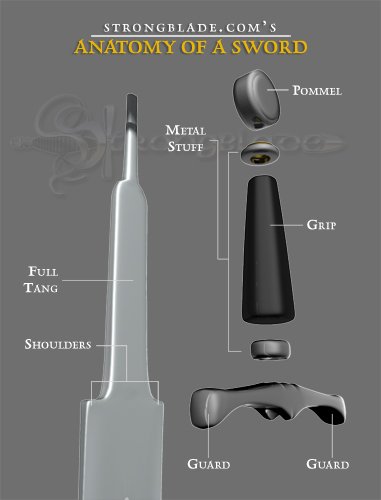
11. Tang: A delicious powdered drink that somehow is linked to astronauts. Also, the tapering part of the sword blade that extends from the shoulders of the blade. This slightly tapered piece of steel becomes the grip of the sword, and the pommel is affixed to the very end of it. Many modern sword tangs are made by welding a ?rat-tail,? between the hips of a sword. The rat-tail is a ground down piece of metal, not much more than a cylindrical stick about the diameter of a thick screw. These types of tangs are, in scientific Oakshott terminology, referred to as, ?uncool.? Tangs wielded onto sword blades are fragile and can be dangerous. Some ?rat-tail? or 'stick? tangs are not wielded onto the blade, but are simply ground down, narrow continuations of the blade. These tangs, though still only as thick as a large screw, are not quite as fragile as wielded tangs, although they are still not as strong as full-tangs (which are far less tapered).
So, there we go, the knightly sword broken down into all of its glorious pieces. Yes, I hear the grumbling. I didn?t answer all of my quiz questions from the start of this post. That is true, young grasshoppers. There are a couple terms I didn?t cover today. You?ll just have to read my next blog posting, where I talk about Rapiers and cut-and-thrust swords to satisfy your curiosity.
Or you can just Google it.
Your choice.
Here are a few examples of arming swords sold by Strongblade. Please visit our Arming Sword page to see a more complete list.


